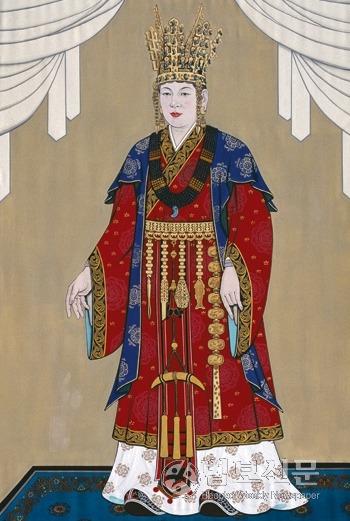lovesouthkorea: Queen Seondeok of Silla was Silla’s twenty-seventh ruler, and its first r
lovesouthkorea: Queen Seondeok of Silla was Silla’s twenty-seventh ruler, and its first reigning queen. She was the second female sovereign in East Asian history and encouraged a renaissance in thought, literature, and the arts in Silla. Although Queen Seondeok led her kingdom in a war-torn and violent era, she was able to hold the country together and advance Silla culture. Her success paved the way for future ruling queens of Silla. Not much is known about Queen Seondeok’s early life. We know that she was born Princess Deokman in 606 CE to King Jinpyeong, who was the 26th king of Silla, and his first queen Maya. Although some of Jinpyeong’s royal concubines had sons, neither of his official queens produced a surviving boy. Princess Deokman was well-known for her intelligence and accomplishments, according to the surviving historical records. When she was a young woman, the Emperor Taizong of Tang China sent a sample of poppy seeds and a painting of the flowers to the Silla court. After studying the picture, Deokman predicted that the flowers would have no scent. When they bloomed, the poppies were indeed odorless. The princess explained that there were no bees or butterflies in the painting - hence her prediction that the blossoms were not fragrant. As the oldest child of a queen, and a young woman of great intellectual power, Princess Deokman was selected to be her father’s successor. The act was not unusual within Silla, however, queens had ruled only as regents for their sons or as queens dowager - never in their own names. When King Jinpyeong died in 632, the 26-year-old Princess Deokman became the first ever outright female monarch, Queen Seondeok. During her fifteen years on the throne, Queen Seondeok used skillful diplomacy to form a stronger alliance with Tang China. The implicit threat of Chinese intervention helped to ward off attacks from Silla’s rivals, Baekje and Goguryeo, although the queen was not afraid to send out her army as well. In addition to external affairs, Seondeok also encouraged alliances among the leading families of Silla. She arranged marriages between the families of Taejong the Great and General Kim Yu-sin; this power bloc would later lead Silla to unify the Korean Peninsula and end the Three Kingdoms period. Queen Seondeok is renowned as a sponsor of the arts and education, but few specific details of her patronage survive. Luckily, some of the buildings she ordered constructed are still standing today. The queen was interested in Buddhism, which was fairly new to Korea at the time but had already become the state religion of Silla. She sponsored the Bunhwangsa Temple construction near Gyeongju in 634 and oversaw the completion of Yeongmyosa in 644. The 80 meter tall Hwangnyongsa pagoda included nine stories, each of which represented one of Silla’s enemies. The wooden Hwangnyongsa pagoda was built as a magical appeal for Silla victories over all of these enemies. Mongol invaders burned it down in 1238. Queen Seondeok’s most famous and enduring monument is also world’s oldest surviving astronomical observatory. Called the Cheomseongdae or “Star-gazing Tower,“ the bottle-shaped structure is formed of granite blocks. There are 12 blocks in the lowest level, signifying the months of the year. 30 levels stand for the days of the month, and there are a total of 366 blocks for the days of the year (including a Leap Day). In addition to the story of the poppy seeds, further legends about Queen Seondeok’s predictive abilities have come down to us. it is said that Seondeok once heard a horde of white frogs croaking by the Jade Gate pond in the winter. She interpreted this as an impending attack from the Kingdom of Baekje (the croaking frogs were seen as angry soldiers) in the northwest of Silla (white symbolized the west in astronomy) at the Women’s Valley (the Jade Gate was associated with women). When she sent her generals to the Women’s Valley, they were able to capture two thousand Baekje soldiers. Some days before she died, Queen Seondeok gathered her courtiers and announced that she would die on January 17, 647. She asked to be buried in the Tushita Heaven. Her courtiers replied that they did not know that location, so she pointed out a place on the side of Nangsan ("Wolf Mountain”). On exactly the day that she had predicted, Queen Seondeok died and was interred in a tomb on Nangsan. Ten years later, another Silla ruler built Sacheonwangsa (“The Temple of Four Heavenly Kings”) down the slope from her tomb. The court later realized that they were fulfilling a final prophecy from Seondeok; in Buddhist scripture, the Four Heavenly Kings live below the Tushita Heaven on Mount Meru. Queen Seondeok never married or had children. In fact, some versions of the poppy legend suggest that the Tang Emperor was teasing Seondeok about her lack of offspring when he sent the painting of the flowers with no attendant bees or butterflies. As her successor, Seondeok chose her cousin Kim Seung-man, who became Queen Jindeok. The fact that another ruling queen followed immediately after Seondeok’s reign proves that she was an able and astute ruler, Lord Bidam’s protestations notwithstanding. The Silla Kingdom would also boast Korea’s third and final female ruler, Queen Jinseong (r. 887 - 897). -- source link
Tumblr Blog : lovesouthkorea.tumblr.com
#queen seondeok
